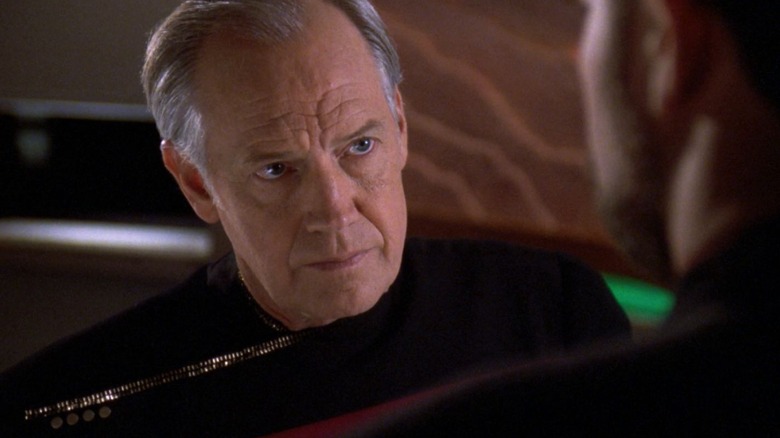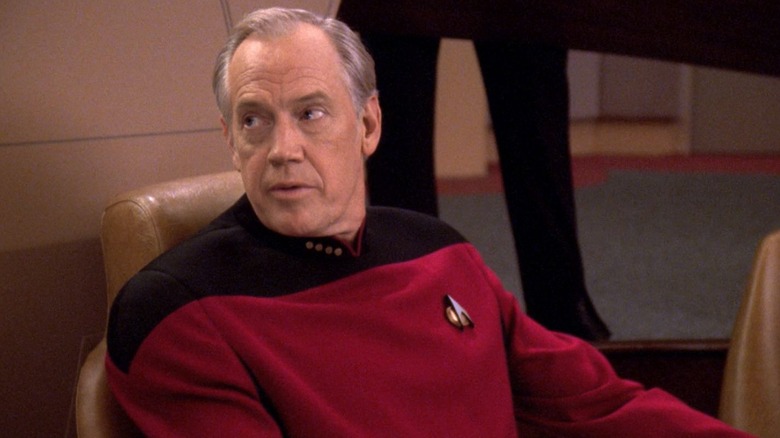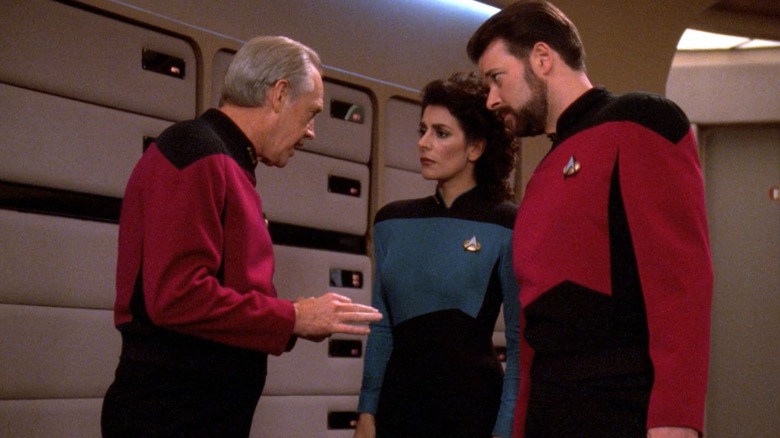Star Trek: The Next Generation Nixed A Major Promotion For Captain Jellico
In the 1992 "Star Trek: The Next Generation" episode "Chain of Command, Part I," Captain Picard (Patrick Stewart), Dr. Crusher (Gates McFadden), and Lieutenant Worf (Michael Dorn) are called away by Starfleet to undertake a dangerous, very secret mission to seek out and apprehend a dangerous biological weapon being developed by the untrustworthy Cardassians. Picard needs to resign as captain of the USS Enterprise in order to undergo this mission, and he is replaced by one Captain Edward Jellico (Ronny Cox), a commanding officer with a dramatically different managerial style.
As a captain, Picard was open to suggestions, careful to keep a rapport open with his crew. Jellico, meanwhile, was stern, cold, and loved to micromanage. He hated casualness and jocularity, and expected everyone to be tightly wound. He wasn't a bad captain — indeed, he was quite good — but he was a terrible boss. The appearance of Jellico set many Trekkies' hearts aflame, as he reminded us that starship captains were always going to be temporary, and that a career in Starfleet will often throw unexpected curveballs at the crew, even someone as established as Picard. Jellico also reminded us that there is a wide variety of command styles in "Star Trek"; not every captain is going to be as warm or open-minded as Picard.
At the end of "Chain of Command, Part II," Jellico relinquished command of the Enterprise back to Picard and the comfortable status quo of "Next Generation" was restored. The character wouldn't be seen again until the "Star Trek: Prodigy" episode "Masquerade" in November of 2022.
But, according to Larry Nemecek's invaluable sourcebook "The Star Trek: The Next Generation Companion," Jellico almost made an appearance in the 1993 episode "Tapestry," back in command of the Enterprise.
Jellico can and Jellico do
The premise of "Tapestry" is intense: Picard dies after suffering a phaser blast to the chest. He awakens in the afterlife, greeted by the playful space deity Q (John De Lancie). Q explains to Picard that his artificial heart malfunctioned, and that if Picard had an organic heart, he would have survived the phaser blast. Picard explains that he lost in heart in a knife fight when he was 21, having instigated a bar brawl with some 7-foot-tall Nausicaans. Q offers to send Picard back in time to rewrite history, stop the brawl, and save his heart. Picard accepts.
The adult Picard, however, had forgotten how impulsive and irresponsible he had been at age 21, and is shocked to find how reckless his friends were. He tries to apply his adult wisdom to his younger self, and he manages to stop the bar brawl he instigated. In so doing, however, Picard alienates his friends, displays a distinct lack of daring, and emerges on the other side cautious, callow, and weak-willed. Wisdom, he finds, cannot be directly applied to youth. He needed to learn by making mistakes.
When Q whisks Picard back to his adult life, now with his organic heart intact, everything is altered. Picard is now a lowly lieutenant on the Enterprise, having made it to his 60s with no career ambition.
The captain of the Enterprise in this altered timeline is said to be a previously unmentioned character named Thomas Holloway. But in the original draft of the "Tapestry" script, writer Ronald D. Moore wanted the alternate Enterprise to be commanded by Edward Jellico. Moore decided against it, though, perhaps feeling that the reference was too insular.
Ronald D. Moore's plan for Jellico
Moore's plan for Jellico was laid out plainly in Nemecek's very thorough book. But before Nemecek could explain it, he had to go into detail about Picard's career arc as a means to illustrate how reckless he remained, even after being stabbed in the back in "Tapestry." To digress briefly: Recall that on the original "Star Trek," Kirk went on away missions all the time. On "Next Generation," Captain Picard always stayed on the bridge, likely because it's a wise rule for Starfleet to have. Through several "TNG" episodes, Picard mentioned that he was still going on away missions while stationed on the USS Stargazer, which, Trekkies know, was Picard's first command. Evidently, something Picard did on the Stargazer inspired Starfleet's rule that captains are banned from away missions. Nemecek laid out all the complex mythology like this:
"Unaware of Bob Justman's formative idea to credit the ban on captains' dangerous beam-downs to Picard, Moore said the brief mention of just such an instance with Picard taking command was meant to show that his 'twenty-two-year mission' on his old ship as laid out in [Gene Roddenberry's] original Writer's Guide was not all spent as captain. Also, he added [...] Jellico ('Chain of Command') was his later-nixed first choice for Enterprise's captain in Picard's altered future."
Moore doesn't say, however, if Jellico was only going to be mentioned as the captain of the Enterprise in the alternate "Tapestry" future, or if the character would appear on camera. It might have been fun to see the callow version of Picard and the unaltered version of Jellico have a conversation. One can see why Jellico was ditched, though. Trekkies would likely be too busy yelling "Hey, it's Captain Jellico!" to fully absorb that Picard's life is now hollow and pathetic.
In the animated series "Star Trek: Prodigy," Jellico was seen to have achieved the rank of Admiral ... and he was just as snippy and petty as he always was. It turns out even micromanaging a-hole captains can rise through the ranks.


